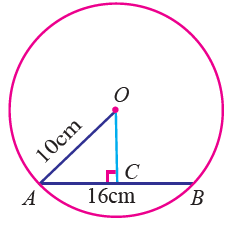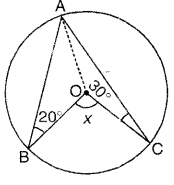MATH PRACTICE PROBLEMS FOR GRADE 7 WITH ANSWERS
Subscribe to our ▶️ YouTube channel 🔴 for the latest videos, updates, and tips.
Question 1 :
The sum of the digits of a two digit number is 15 and if 9 is added to the number the digits are interchanged.Find the required number.
(A) 78 (B) 19 (C) 82
Solution :
Let "xy" be the required two digit number
x + y = 15 ------(1)
xy + 9 = yx
10x + 1y + 9 = 10y + 1x
10x - x + 1y - 10y = -9
9x - 9y = -9 ------(2)
Divide (2) by 9, we get
x - y = -1 ------(2)
x + y = 15
x - y = -1
------------------
2x = 14 ==> x = 7
By applying the value of x in the first equation, we get
7 + y = 15
Subtract both sides by 7,
y = 15 - 7 = 8
So, the required number is 78.
Question 2 :
Two trains with a speed of 35 km per hour and 28 km per hour respectively,starting at the same time, run in the opposite directions between two stations A and B, 315 km apart.Find where they will meet
(A) 180 km apart from A (B) 130 km apart from A
(C) 175 km apart from A
Solution :
Let both trains meet at x distance from station A
|
TRAIN 1 : distance = x speed = 35 time = x/35 |
TRAIN 2 distance = 315-x speed = 28 time = (315-x)/28 |
the time when they meet will be equal
x/35 = (315-x)/28
x/5 = (315-x)/4
4x = 1575 - 5x
9x = 1575 ==> x = 175
t = x/35 ==> 175/35 ==> 5
So, the trains will meet at 175 km apart from station A and after 5 hrs.
Question 3 :
The sum of two number is 135 and are in the ratio 4:5.Find the required numbers.
(A) 80,95 (B) 60,75 (C) 30,35
Solution :
Let the two numbers be 4x and 5x
4x + 5x = 135
9x = 135
x = 135/9 ==> 15
4x = 4(15) = 60
5x = 5(15) = 75
So, the required numbers are 60 and 75.
Question 4 :
The sum of two numbers is 3000. If 8% of one number is equal to 12% of the other, find the numbers.
(A) 1800 and 1200 (B) 2240 and 2800
(C) 2700 and 3100
Solution :
Let the two numbers be x and y.
Given, x + y = 3000
Also,
We got x = 3y/2
But x + y = 3000
3y/2 + y = 3000
5y/2 = 3000
y = 3000 × 2 / 5 = 1200
So, x = 3(1200)/2 = 1800
Hence the numbers are 1800 and 1200
Question 5 :
Solve the following 2(6x-5) = (3x+2) + 6
(A) 2 (B) 5 (C) 3
Solution :
2(6x-5) = (3x+2) + 6
12x - 10 = 3x + 2 + 6
12x - 3x = 8 + 10
9x = 18
Divide both sides by 9
x = 18/9 = 2
Question 6 :
A chord of length 16 cm is drawn in a circle of radius 10 cm. Find the distance of the chord from the centre of the circle.
(A) 30 cm (B) 25 cm (C) 12 cm
Solution :

AB is a chord of length 16 cm
C is the midpoint of AB.
OA is the radius of length 10 cm
AB = 16 cm
AC = (1/2) ⋅ 16 = 8 cm
OA = 10 cm
In a right triangle OAC.
OC2 = OA2 - AC2
OC2 = 102 - 82
OC2 = 100 - 64 = 36 cm
OC = 6 cm
So, the distance of the chord from the centre is 6 cm.
Question 7 :
In the figure, O is the center of the circle, <ABO = 30°, where A, B and C are points on the circle . What is the value of "x" ?
(A) 60° (B) 100° (C) 50°
Solution :

In triangle OAB, we have
OA = OB
<OAB = <OBA = 20°
In triangle OAB, we have
OA = OC
<OAC = <OCA = 30°
<BAC = <OAB + <OAC
= 20° + 30° = 50°
x = <BOC = 2<BAC
= 2(50°) = 100°
So, the required angle is 100°.
Question 8 :
The base of the parallelogram is twice the height.If the area is 578 find the base and height.
(A) Height = 10 cm and Base = 20 cm
(B) Height = 17cm and Base = 34 cm
(C) Height = 15 cm and Base = 10 cm
Solution :
Let "x" be the base of the parallelogram
height = 2x
Area of parallelogram = 578
x (2x) = 578
2x2 = 578 ==> x2 = 289
x = 17 cm
2x = 2(17) = 34 cm
So, the base and height of the parallelogram are 17 and 34 cm respectively.
Question 9 :
The perimeter of a triangle field is 144 m and the ratio of the sides is 3:4:5.Find the area of the field.
(A) 318 m2 (B) 522 m2 (C) 864 m 2
Solution :
Sides of the triangle are 3x, 4x and 5x
Perimeter of the triangle = 144 m
3x + 4x + 5x = 144
12x = 144
Divide both sides by 12
x = 144/12 = 12
3x = 3(12) = 36
4x = 4(12) = 48
5x = 5(12) = 60
Area of scalene triangle = √s (s-a) (s-b) (s-c)
s = 144/2 = 72
s - a = 72 - 36 = 36
s - b = 72 - 48 = 24
s - c = 72 - 60 = 12
= √(72 ⋅ 36 ⋅ 24 ⋅ 12)
= 864 m2
Question 10 :
The circumference of a circle exceeds the diameter by 20 cm. Find the radius of the circle.
Solution :
Let the radius of circle of = r m.
Then circumference = 2 πr
Since, circumference exceeds diameter by 20
2 πr = d + 20
2 πr = 2r + 20
2 × (22/7) × r = 2r + 20
44r/7 - 2r = 20
(44r - 14r)/7 = 20
30r/7 = 20
r = (7 ⋅ 20)/30
r = 14/3
So, the radius of circle is 14/3 cm.
Subscribe to our ▶️ YouTube channel 🔴 for the latest videos, updates, and tips.
Kindly mail your feedback to v4formath@gmail.com
We always appreciate your feedback.
About Us | Contact Us | Privacy Policy
©All rights reserved. onlinemath4all.com

Recent Articles
-
90 Degree Clockwise Rotation
Jan 01, 26 06:58 AM
90 Degree Clockwise Rotation - Rule - Examples with step by step explanation -
US Common Core K-12 Curriculum Algebra Solving Systems of Equations
Jan 01, 26 04:51 AM
US Common Core K-12 Curriculum - Algebra : Solving Systems of Linear Equations -
Solving the HARDEST SAT Math Questions ONLY using Desmos
Dec 31, 25 05:53 AM
Solving the HARDEST SAT Math Questions ONLY using Desmos
